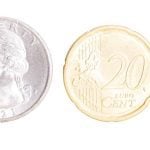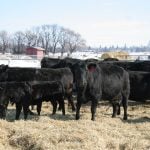It was a big one.
A 205 pound heifer calf that was born to a seven-year-old Charolais cross cow on March 19 is one of the largest live-born calves known to researchers.
Marthe and Dennis Osmachenko of Sonningdale, Sask., thought the cow might be expecting twins from its size, but were shocked to discover that all that calf mass belonged to one animal.
“It was huge, and the mom needed some help with the delivery, but it went pretty well and she is fine,” Dennis said.
Read Also

Lending policy still focused on primary producers: Farm Credit Canada
Farm Credit Canada said it has not changed its business practices and remains committed to supporting all producers, after a report from an Ottawa-based media outlet claimed otherwise.
The red calf had a normal gestation period and other than its size appeared to be performing normally in its first few days of life.
The calf lived for about a week before starting to fail.
“Unfortunately, it began having breathing difficulties, its front leg joints began to swell and we realized we’d have to euthanize it,” he said.
It was sired by either a red-factor Charolais or a Red Angus at the local community pasture.
Terry Caruthers of the Western College of Veterinary Medicine at the University of Saskatchewan said he has heard of calves in the 150 to 160 lb. range being born alive, but not 205.
He said the early days of cloning saw embryo splits that were born oversize, but not as large as the Sonningdale calf.
“The biggest part of the growth is in the last trimester, so something must have happened to trigger this huge daily gain.”
He said a pituitary tumour in a cow can cause larger than normal releases of growth hormones, but because an autopsy wasn’t performed on the calf there is no way to determine the cause of its unusual size.
Sheila Schmutz, a geneticist with the U of S, said larger than average sizes can come from fetal overgrowth syndrome.
“This usually is not a healthy thing to happen, but I have not heard of a calf being born this big before,” she said.
Caruthers said abnormalities likely weren’t limited to the size of the animal and problems with organ development may have led to the calf’s premature death.
Rod Dale of Plunkett, Sask., was experiencing his own larger than normal calving this year, but it came in the form of quadruplets from a cow that last year delivered quintuplets.
“We were just surprised she was able to conceive again this year, let alone have multiple births,” he said of his Simmental and Angus cross cow.
In both years, only a single calf survived.














